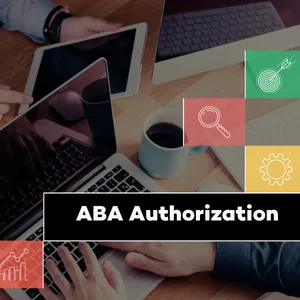Last updated on October 27th, 2025

Navigating the authorization process can be overwhelming for applied behavior analysis (ABA) providers. Ensuring clients receive the necessary insurance coverage for ABA therapy requires an understanding of insurance authorization, medical billing, and compliance with health insurance requirements. Obtaining approval often involves a complete assessment of the client’s needs, adherence to state and federal laws, and meeting insurance mandate requirements. Therapy providers must carefully document treatment plans to demonstrate the medical necessity of care for individuals with autism. Understanding insurance benefits and coverage limitations is crucial to ensuring clients receive ongoing care. This guide provides a step-by-step overview of the insurance authorization process, helping autism providers successfully secure and maintain coverage for their clients.
What is ABA Authorization?
To put it simply, it’s the process of obtaining approval from an insurance company before providing applied behavior analysis (ABA) therapy. This prior authorization ensures that certain services are covered under a client’s health insurance plan, preventing unexpected costs. Without proper authorization, ABA providers may struggle with medical billing issues and delays in payment. The authorization process is essential for ensuring that ABA services remain accessible and sustainable for families needing autism treatment.
Insurance companies require prior authorization to verify that ABA therapy aligns with the child’s ASD diagnostic report and treatment plan. This process helps control healthcare costs while ensuring behavioral therapy sessions meet the necessary standards for health care coverage. Some states have a mandate requiring insurance providers to cover ABA therapy for autism, but authorization is still needed to navigate approvals and avoid claim denials. Additionally, providers must ensure they are in-network with insurance companies to streamline the approval process, reduce out-of-pocket pay for families, and maintain financial stability within their practice.

Key Steps in the ABA Authorization Process
Step 1: Verifying Insurance Coverage
Families seeking ABA therapy often have many questions about what their child’s insurance will cover and what out-of-pocket expenses they may face. Before beginning treatment, therapy providers must verify a client’s health insurance network coverage. This step ensures the provider understands what services are covered, whether prior authorization is needed, and any potential out-of-pocket costs for the client. Insurance companies have different policies regarding ABA therapy, and failing to check for coverage can lead to denied claims and unexpected expenses for families seeking treatment.
Step 2: Submitting a Prior Authorization Request
Once insurance verification is complete, the next step is to put in a prior authorization request. This involves gathering and submitting required documents, such as the treatment plan, ASD diagnostic report, and any additional assessment reports. The insurance company will review the appeal to determine if the recommended ABA care meets their coverage criteria. Some insurance plans have specific mandates in place, requiring providers to submit these documents at regular intervals. Proper documentation is crucial in ensuring a smooth insurance authorization process
Step 3: Initial Treatment Plan Authorization
If the prior authorization request is approved, the insurance company grants authorization for an initial treatment plan. This allows behavioral providers to begin delivering services to the child, ensuring that interventions are tailored to their unique needs. Providers must follow insurance company guidelines to ensure compliance with health insurance requirements.
Step 4: Ongoing Services Authorization
ABA services require ongoing approval to ensure continued coverage. An assessment is often required at regular intervals, where providers must upload updated progress reports and treatment plan adjustments. Maintaining detailed records and providing timely assessment reports helps avoid service interruptions and ensures providers pay for their services

Common Challenges in the ABA Authorization Process
The authorization process is often complex and time-consuming. Providers frequently face challenges such as:
- Delays in prior authorization approval: Insurance companies may take weeks to process requests, delaying treatment.
- Claim denials due to incomplete documentation: Missing or incorrect paperwork can result in rejected claims.
- Navigating different insurance policies: Coverage varies across insurance companies, Medicaid, and Medicare, requiring providers to stay informed about policy changes.
- High administrative burden: Managing the insurance authorization process takes significant time and resources, impacting service delivery.

Best Practices for Securing and Maintaining ABA Authorization
To streamline the insurance authorization process and minimize challenges, ABA providers can adopt these best practices:
- Stay proactive with insurance verification: Regularly check client health care coverage to stay informed about policy updates and coverage limitations.
- Ensure complete and accurate documentation: Provide all required information, including therapy care plans, assessment reports, and re-evaluation data.
- Leverage technology for efficiency: Using software solutions designed for industry billing and revenue cycle management, similar to Raven Health’s, can help simplify the authorization process.
- Train your billing team : A well-trained team understands the complexities of billing, improving accuracy and reducing claim denials. Learn more about ABA billing training.
- Monitor re-evaluation deadlines: Stay ahead of insurance company requirements by tracking when re-evaluations are due to avoid service disruptions.

Ensuring a Smooth ABA Authorization Process
By understanding the insurance authorization process and implementing best practices, ABA providers can reduce delays, secure payment, and focus on providing high-quality services. Keeping up with health insurance laws, maintaining ABA compliance, and ensuring proper documentation will help streamline the process. Providers should also prioritize ongoing training and process optimization to manage insurance authorizations effectively. By securing proper authorization, providers can focus on what matters most—helping each child reach their full potential through evidence-based therapy.

Using Raven Health for Your ABA Business
Managing the authorization process can be daunting, but Raven Health simplifies the journey. With over a decade of experience supporting ABA providers, Raven Health offers intuitive AI-driven solutions for medical billing, revenue cycle management, and prior authorization tracking—so you can spend less time on paperwork and more time on patient care.
Our platform is built to streamline workflows, reduce claim denials, and improve operational efficiency, ensuring ABA providers secure insurance coverage without unnecessary delays. By eliminating administrative bottlenecks and automating critical processes, Raven Health helps practices scale with confidence while maintaining compliance and maximizing reimbursement.
Whether you’re a solo provider or a growing a new organization, our data-driven, user-friendly platform adapts to your needs, enabling smarter decision-making and seamless authorization management.
Ready to optimize your ABA practice? Sign up for Raven Health’s free 30-day trial and experience the difference firsthand!
